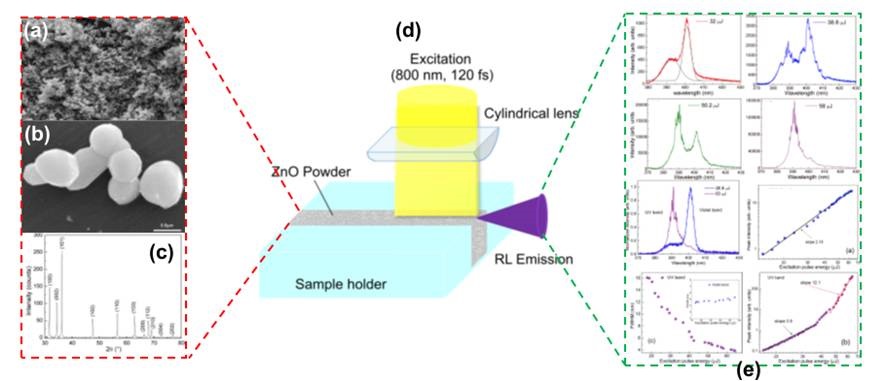Paper: Multi-photon excited coherent random laser emission in ZnO powders. Dominguez, CT; Gomes, MA; Macedo, ZS; de Araujo, CB; Gomes, ASL. Nanoscale, 2015, 7, 317-323. DOI: 10.1039/C4NR05336B.
A team of Brazilian scientists developed a random-type laser (random laser) that opens new possibilities of applications for this type of device, especially in medicine. The novelty was reported in an article recently published on the scientific journal Nanoscale.
In a laser, the light is generated by the emission of photons in cascade effect: electrons properly stimulated emit photons, which stimulate new electrons that emit other photons, which stimulate other electrons and so on. In order to have a laser working, it is required to have more excited electrons than non-excited ones – situation which is called “population inversion”.
In the conventional laser, the population inversion only occurs when the light is confined in a “gain medium”, which is confined within an arrangement of parallel mirrors, known as optical cavity. In such gain medium, the light goes and comes, stimulating electrons and generating the cascade effect explained above. But in the random laser, the confinement of the light occurs due to the strong scattering performed by nanometric particles that are embedded in the gain medium material. An optical cavity is not needed in this case. Before leaving the random laser, the light travels a long random path producing stimulated emission. If at the end of the path, the light comes back to its original scattering center, it is a random laser of coherent feedback.
In the work reported in Nanoscale, the authors used zinc oxide (ZnO) powder as gain medium. Its particles also worked as scatterers. The material was synthesized by a green and low-cost method, called proteic sol-gel, following an innovative route based on the use of coconut water in the polymerization stage of the metallic precursor. The process generated a compound of quality equivalent to the one produced by traditional manners.
“Our team developed for the first time a random laser with coherent feedback emitting ultraviolet light, from a powder composed by sub-micrometric particles of ZnO, using optical excitation in the infrared,”, summarizes Christian Tolentino Dominguez, first author of the article published in Nanoscale.
According to him, the work opens possibilities for several applications of the random laser light; for example, in the activation of fluorophores or drugs for therapeutic use, as lighting source to obtain high quality biomedical images, and also as lighting source in optical coherence tomography (OCT) devices, pico projectors, and cinema projectors.
The team also obtained experimental evidence to state that the emission of UV of the random laser of ZnO powder was induced by the simultaneous absorption of 3 photons in the near infrared region. “Due to its broad band gap (~3.37 eV), the ZnO is virtually transparent at visible light, but its conduction band may be accessed by electrons excited by light with wavelenght located in the the near infrared region, by a non-linear optical process that involves the absorption of several photons in a simultaneous manner”, explains Tolentino.
(a) and (b) Images of electronic scanning microscope showing the particles of ZnO in different magnifications, (c) X-ray diffraction of the particles, (d) Scheme showing the experimental configuration, (e) Emission spectra at different excitation energies and curves showing the characterization of the random laser: band narrowing and non-linear behavior due to the excitation energy.
The work was developed, mainly, in the Photonics and Biophotonics Laboratory at the Federal University of Pernambuco (UFPE), headed by Professors Anderson Gomes e Cid B. de Araújo. It was carried out during a post-doctoral internship of Christian Tolentino, who currently works in the Biomedical Engineering Laboratory, also at UFPE. The synthesis of the particles was performed by the group of Advanced Ceramic Materials at the Federal University of Sergipe (UFS), headed by the Professor Zélia Soares Macedo.
The research was funded by the Brazilian national research foundation (CNPq) and by the Pernambuco state research foundation (FACEPE). It was held in the context of the National Institute of Science and Technology in Photonics, which has performed active research in the area of random laser, having several papers.

